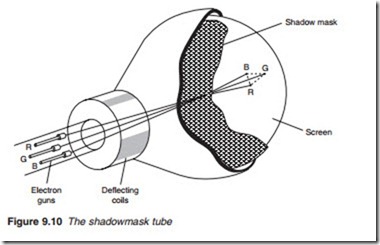Convergence
The three electron beams scanning the screen produce three separate rasters as illustrated in Figure 9.9 thus rendering the problem of raster correction considerably more complicated compared with those encountered with
monochrome displays. The three rasters must not only be of the correct rec- tangular shape with no pincushion distortion, they must also coincide pre- cisely. This is known as convergence. There are two types of convergence, static and dynamic. Static convergence relate to the central part of the picture. Dynamic convergence covers the rest of the screen which involves the estab- lishment of a continuously varying (dynamic) magnetic field to ensure con- vergence at the outlying areas and corners of the display. As we will see later, this requires electromagnetic waveforms which are a function of both the line and field frequencies.
The shadowmask tube
The first mass-produced colour tube was the delta-gun shadowmask. It has three electron guns mounted at 120º to each other at the neck of the tube each with its own electron lens. The guns are tilted by a small amount towards the central axis of the tube so that their electron beams converge and cross at the shadowmask and pass through carefully positioned holes to strike their correct phosphor dot. A large number of electrons miss their holes and are lost by hitting the mask resulting in what is known as low electron transparency resulting in low efficiency and low brightness. In the delta arrangement (Figure 9.10), the three guns are in three different planes making it difficult to achieve accurate conversion as the beams are made to scan the screen. This is the main disadvantage of the delta type. Highly complex and expensive convergence circuits are necessary to overcome the two dimensional distortion of the rasters and to maintain good convergence. Several presets have to be used in a complex sequence
requiring highly skilled labour. Furthermore, the tendency for convergence to drift means frequent adjustments are necessary. For this reason, delta-gun tubes are no longer used for domestic TV receivers. However, they are still in production for use as monitors for advanced computer displays because of their high definition when fitted with a very fine-pitch shadowmask.
The in-line colour tube
In the in-line shadowmask tube the three guns are placed side by side and the phosphors coating on the screen is in the form of striped triads. Each 3-colour group is arranged to coincide with a longitudinal grill or slot in the shadowmask. Having three beams in the same horizontal plane has two advantages.
First, purity is unaffected by horizontal magnetic fields such as the earth’s magnetic field. Secondly, the need for vertical conversion correction disappears because the three beams always travel in the same hori- zontal plane. Convergence is then reduced to the relatively easy task of deflecting the two outer beams inward slightly to converge with central beam. The first in-line tube was developed by Sony known as the Trinitron. This was followed by the Mullard’s precision-in-line, PIL (AX series) self- converging tube which eliminated the need for dynamic convergence adjustment altogether.
